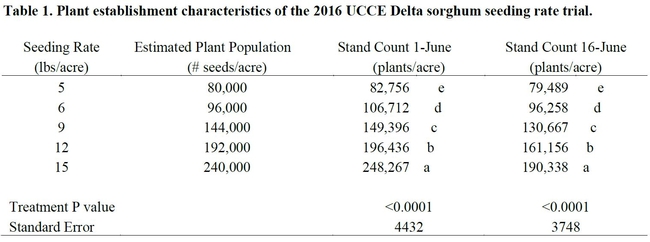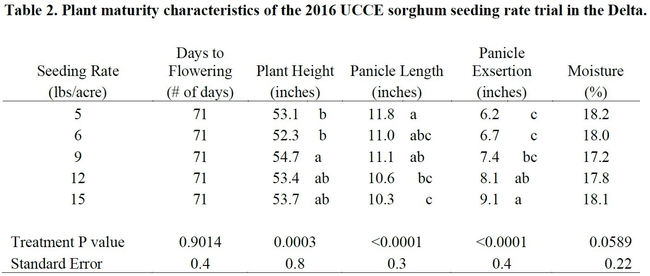(There was an error in the previous version of this blog post. The error has been corrected here and in the full report, available from my website.)
The purpose of this trial was to better understand optimal seeding rates for grain sorghum grown in the Sacramento-San Joaquin River Delta – a unique agricultural region known for its fertile, organic soils, shallow groundwater, and cooler climate conditions. The trial was planted in the Sacramento-San Joaquin Delta, on Tyler Island in Sacramento County. The soil is a Rindge mucky silt loam with approximately 20 percent organic matter in the top 15 inches of soil. The Rindge series is a mucky peat soil down to about 60 inches, and approximately 55,600 acres in the Delta are described by the Rindge classification. The plot was planted on May 20, 2016 using a John Deere cone planter. Seed was planted approximately 2 inches deep. The trial was a white sorghum variety, Eureka Seeds 3292, which was the grower's variety. The variety has 16,000 seeds/lb and 85 percent germination, according to the label. Five seeding rate treatments (5, 6, 9, 12, and 15 lbs/acre) were replicated over four blocks positioned down the rows. The seeding rates are expressed as plant populations in Table 1. (The number of sorghum seeds/lb is highly variable across varieties. For this reason, when determining seeding rates, growers should first determine their desired plant population. A worksheet for calculating seeding rate from desired plant population is available from the full report.) Each plot consisted of four rows (30-inch row spacing) that were 45 feet in length. The previous crop in the field was wheat. Subsurface irrigation by “spud ditch” sub-surface irrigation was employed twice. The field was fertilized at planting with 35 gallons/acre of 8-24-0 with ½ percent of zinc. The field was cultivated one time, and Maestro 4EC (8 oz/acre), AAtrex 4L (0.75 pint/acre), and Crosshair (4 oz/acre) were applied for post-emergence weed control in mid-June. The plot was harvested on November 14, 2016 using an Almaco research combine, harvesting the center two rows from the four-row plots.
Trial results are presented as plant establishment characteristics (Table 1), plant maturity characteristics (Table 2), and yield (Figure 1). The tables and figure present mean values for the four replicates. Tukey's range test was the statistical method used to compare the means. Varieties were considered statistically different if their P value was less than 0.05, or 5 percent. Differences between treatments are indicated by different letters following the mean.
The estimated plant populations for the treatment seeding rates were calculated using the number of seeds/lb and percent germination for this variety. Stand counts were made as the number of plants/10-foot row length on June 1st and June 16th, and these counts were scaled up to plants/acre. Stand counts were as expected - higher counts for the higher seeding rates. Stand counts for all treatments decreased from June 1st to June 16th, but stand counts remained on target with the estimated plant population for the 5 and 6-lb seeding rates. Weeds were also counted in the month after planting and in the month before harvest (data not shown), but overall weed pressure was very low at this location.
There were no differences in the number days to flowering among treatments; however, there were differences among treatments in the other maturity characteristics. The higher seeding rate plots had taller plants with longer panicle exsertion (the length of the stem from the top leaf to the bottom of the panicle), which may suggest that at these higher densities, plants were competing with each other and growing taller. Panicles were longest in the 5 lb seeding rate and statistically longer than the panicles in the 12-lb and 15-lb rates. There were no statistical differences in grain moisture at harvest.
The treatment yields do not provide a clear take-home message of the results, except perhaps to show that the highest seeding rate (15 lbs/acre) is not an optimum seeding rate. However, if the 9-lb treatment was ignored, there would be a trend for yield to decrease as the seeding rate increased. A possible explanation for the high yield of the 9-lb treatment is that there were three of these plots proximal to the sub-irrigation ditches, which were exterior to the experiment on both sides. The 9-lb treatment may have been inadvertently favored with better moisture conditions as a result of the experimental design. In hindsight, the experiment should have been blocked across the rows instead of down the rows to account for these field conditions which may have introduced variability in soil moisture. Blocking down the rows accounted for very little unexplained variability, and in future years, the experiment will be designed to account for the variability across the rows.
In summary, it is important to study sorghum cultural practices in the Sacramento-San Joaquin Delta region because crop acreage appears to be increasing, and the Delta is a unique growing region of California. Sorghum seeding rates as a function of plant population were studied to assist growers with determining optimum rates for the Delta environment. While results are somewhat inconclusive, there appears to be a trend for the lower seeding rates to yield the highest. If this trend is shown in future years, then Delta growers could have higher productivity with lower seed costs.


